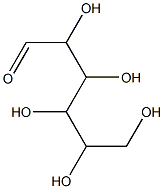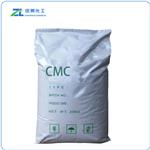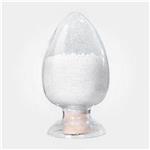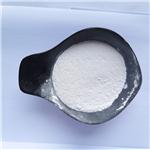Product features
Carboxymethyl cellulose (CMC) is tackifier, at room temperature, it is non-toxic tasteless white flocculent powder, it is stable and soluble in water, aqueous solution is neutral or alkaline transparent viscous liquid, it is soluble in other water-soluble gums and resins, it is insoluble in organic solvents such as ethanol. Carboxymethyl cellulose is the substituted product of cellulosic carboxymethyl group. According to their molecular weight or degree of substitution, it can be completely dissolved or insoluble polymer, the latter can be used as the weak acid cation of exchanger to separate neutral or basic proteins.
Carboxymethyl cellulose can form highly viscous colloidal solution with adhesive, thickening, flowing, emulsifying, shaping, water, protective colloid, film forming, acid, salt, suspensions and other characteristics, and it is physiologically harmless, so it is widely used in the food, pharmaceutical, cosmetic, oil, paper, textiles, construction and other areas of production.
Application: It is used in cigarette adhesive, fabric sizing, footwear paste meal, home slimy. It is used in interior painting architectural, building lines melamine, thickening mortar, concrete enhancement. It is used in refractory fiber, ceramic production molding bond. It is used in oil drilling, exploration address slurry thickening, reducing water loss, quality paper surface sizing. It can be used as soap and washing powder detergent active additives, as well as other industrial production on the dispersion, emulsification, stability, suspension, film, paper, polishing and the like. Quality product can be used for toothpaste, medicine, food and other industrial sectors.
Instructions: Warm water and cold water can be ok when prepares the solution, it can be used with stirring until it completely melts. The amout of added water depends on variety and the use of multiple requirements.
High viscosity sodium carboxymethyl cellulose (HV-CMC) is a white or slightly yellow fibrous powder, hygroscopic, odorless, tasteless, non-toxic, easy to ferment, insoluble in acids, alcohols and organic solvents, easily dispersed to form colloidal solution in water. It is reacted by the acid and fibrous cotton, it is mainly used for water-based drilling fluids tackifier, it has certain role of fluid loss, it has strong salt and temperature resistance especially.
The above information is edited by the chemicalbook of Wang Xiaodong.
Uses
CMC can significantly increase the viscosity of the solution as thickener, dispersion, emulsification, suspension, protective colloid and so on when it is dissolved in water, and it is physiologically harmless, it is widely used in the food, pharmaceutical, cosmetic, oil, paper, textiles, construction and other areas of production.
Chemical Properties
White or almost white powder, hygroscopic.
Chemical Properties
Cellulose is a natural substance normally present in most diets because it is the major structural carbohydrate of green
plants. Cellulose is essentially a linear polymer of glucopyranose units connected by α-1,4-glucoside links. In nature, cellulose is
present in plant cell walls as fibers. The molecular weight of the isolated cellulose is approximately 50,000 daltons. The principal
sources of cellulose for food-related purposes are cotton linters and wood pulp.
Chemical processing converts cellulose into forms or derivatives suitable for incorporation into food products or for use in food
packaging materials. For food use, the optimum degree of substitution of a carboxymethyl-residue on each anhydroglucopyranose
unit on cellulose is 0.95. By preliminary mild acid hydrolysis, the degree of polymerization (i.e., molecular size) of the cellulose
may be reduced before carboxymethylation. Control of the degree of substitution and the degree of polymerization during processing
results in production of a wide variety of derivatives that differ in such physical properties as gelling, temperature, viscosity and
dispersibility in water. Sodium carboxymethyl cellulose is used as a thickening agent and stabilizer in foods. Because carboxymethyl
cellulose is spontaneously converted to sodium salt in alkaline solution, it is probable that any distinction between carboxymethyl
cellulose and sodium carboxymethyl cellulose in foodstuffs is artificial.*
Uses
Carboxymethylcellulose(CMC) is a gum that is water-soluble cellulose ether manufactured by reacting sodium monochloroacetate with alkali cellulose to form sodium . It dissolves in hot or cold water and is fairly stable over a pH range of 5.0–10.0, but acidification below pH 5.0 will reduce the viscosity and stability except in a special acid-stable type of CMC. A variety of types are available which differ in viscosity and degree of substitution (the number of sodium groups per unit). It functions as a thickener, stabilizer, binder, film former, and suspending agent. It is used in a variety of foods to include dressings, ice cream, baked goods, puddings, and sauces. The usage range is from 0.05 to 0.5%. Also termed cellulose gum.
Uses
Pharmaceutic aid (suspending agent); pharmaceutic aid
(tablet excipient); pharmaceutic aid (viscosity-increasing
agent).
Uses
carboxymethyl cellulose (cellulose gum) is a thickener. used in cosmetic formulations when a reactant is not required or desired. often used in bath preparations, beauty masks, hand creams, and shampoos. It is considered a non-comedogenic raw material.
Preparation
Sodium carboxymethyl cellulose is produced by treating wood pulp or cotton linters with alkali and monochloroacetic
acid. It occurs as a white- or cream-colored powder or granules.
brand name
Celluvisc (Allergan); Refresh Plus, Cellufresh
Formula (Allergan).
Industrial uses
Lignin sulfonate is used as dispersant,
flocculant and depressant. Lignin is an amorphous polyphenolic compound
derived from enzymatic polymerization of three phenylpropanoid monomers.
Industrial uses
Carboxymethyl cellulose is manufactured with molecular weights ranging from 50,000
to 800,000. Several modifications are of interest to flotation because they display good
depressing properties for highly floatable magnesium-bearing minerals. These include
sodium salts of phenolphthalein ether cellulose and ethanesulfo cellulose.
Carcinogenicity
Sarcomas were produced at the
site of repeated subcutaneous injection of aqueous solutions of carboxymethylcellulose. It should be noted, however, that
massive doses were given and therefore there must have been
considerable local trauma.



